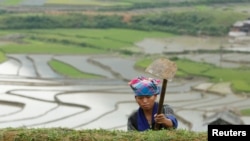Asia’s agricultural sector faces challenges beyond food production, as climate change and changing lifestyles affect rates of nutrition and obesity, a senior official with the U.N. Food and Agriculture Organization says.
Kundhavi Kadiresan, FAO assistant director-general and regional representative for Asia and the Pacific, says almost half a million people in Asia are undernourished.
Under the Millennium Development Goals, the number of undernourished people in the developing world fell from almost 50 percent from 1990 to 2015, but Kadiresan says nutrition and hunger remain major issues.
“Although we have made tremendous progress with the MDG's we still have close to 490 million people in the region who are undernourished in Asia,” Kadiresan told VOA.
Kadiresan, a former World Bank economist, says the problems lay beyond simple food production.
“It is just not the issue of hunger, but largely coming from micronutrient deficiency. So in that sense, we’ll have to look at how best to improve the nutrition aspect of people in the region,” she said.
Solutions
Solutions lay in crop diversification to broaden diets, and providing better awareness and education.
“It’s not about producing more food in the country, but what you produce, how you produce, and how you eat the food. It’s not about growing more rice, but also the variety of crops that has much more balanced nutrition,” she said.
She added that poor nutrition was not simply confined to the very poor amid rising trends of obesity in the region.
“It is often the middle class which also has very poor eating habits. So in that sense, greater awareness in terms of importance of having a balanced diet is also becoming very important,” she said.
The 2016 Global Nutrition Report, released Tuesday, found malnutrition affected one in three people and included the growing trend of obesity.
The independently published report warned malnutrition and diet are “by far the biggest risk factors for the global burden of disease,” with every country facing “a serious health challenge from malnutrition”.
Under-nutrition and obesity
The report said 44 percent of countries were experiencing “very serious levels” of under-nutrition and obesity; but, in Asia, the percent of the population undernourished declined to 14 percent in 2015, from 25 percent in 1991.
Within child populations the main issues were stunting, wasting and obesity, with 25 percent of children under five, 91 million children, affected by stunting. The number of children overweight was estimated at 19.5 million.
Kadiresan said beyond basic nutrition and food production, Asia agriculture faced challenges wrought by climate change, food safety, the depletion of fish stocks, and the rural urban drift that left an aging population on farms.
“The projections are that climate change is going to increase the temperature in the region, which means it is going to have a serious impact in terms of yield of some main crops,” she said.
“So in that sense how do we have much more climate resistant crops varieties that can be more popularized among farmers [by] better water management practices?” she said.
Greater support for women in the rural areas was also needed. Close to 43 percent of women globally engaged in agriculture, but only 20 percent of women had access to land. Kadiresan says the key for Asia’s agriculture sector will be to ensure it is more productive and competitive.








